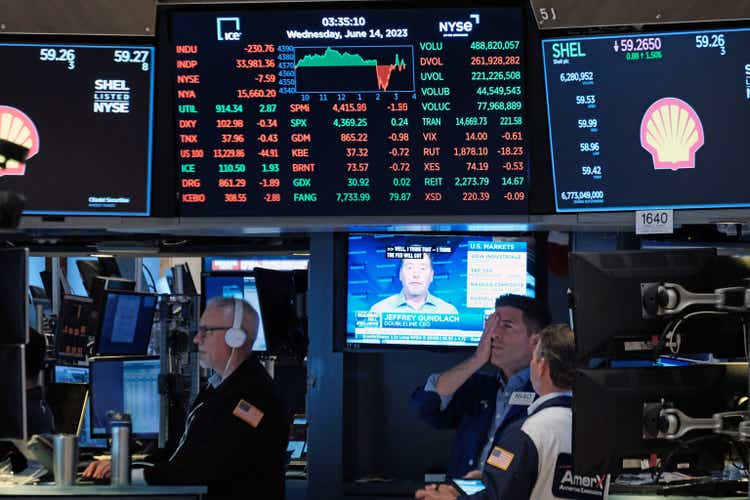Spencer Platt/Getty Images News
Wall Street’s major averages on Monday were deep in negative territory, weighed down by a decline in financial stocks following a rating downgrade of several small and mid-sized lenders.
The global financial sector overall was under pressure after a shock move by Italy in the form of a one-off windfall tax on domestic banks. Sentiment was also weighed down by weak trade out of China.
Approaching mid-day, the tech-heavy Nasdaq Composite (COMP.IND) had slumped 1.57% to 13,775.00 points. The benchmark S&P 500 (SP500) was lower by 1.10% to 4,468.77 points, while the blue-chip Dow (DJI) retreated 0.99% to 35,121.87 points.
All 11 S&P sectors were down, with the exception of Health Care.
Financials slipped 1.6% after rating agency Moody’s cut credit ratings on multiple small and mid-sized banks, while placing six larger lenders on review for downgrade to reflect U.S. banking stresses including funding pressures, regulatory capital weaknesses and commercial real estate exposure.
The SPDR Regional Bank ETF (KRE) and the Invesco KBW Regional Bank ETF (KBWR) fell 2.6% and 3.8%, respectively. Heavyweight names Goldman Sachs (GS) and JPMorgan (JPM) were among the top percentage losers on the Dow (DJI).
Earlier, Italy’s cabinet approved a 40% windfall tax on profits reaped by banks from elevated interest rates. The news sent domestic bank stocks spiraling and sparked a more than 7% plunge in the FTSE Italia All-Share Banks Index. The broader Euro STOXX Banks Index (SX7E) fell more than 3% and European equities were in negative territory.
Market participants also had to contend with economic data out of China that showed a double digit drop in both export and imports for July. The numbers pointed to a larger troubling trend of stagnating growth in the world’s second-largest economy in a year where it was supposed to come rumbling back to life after the end of zero-COVID policies.
The U.S. economic calendar was fairly light on Tuesday, with the goods and services trade shortfall narrowing less than forecast in June.
Treasury yields continued to show volatility, especially in the longer-end 10-year yield (US10Y). The instrument flitted on either side of the 4% mark, having hit a high of 4.21% as recently as Friday amid last week’s bond sell-off. The more rate-sensitive 2-year yield (US2Y) was up 2 basis points to 4.78%.
“We’ve had some big moves in rates in the last week following the U.S. Treasury announcement last Monday, the Fitch U.S. downgrade, the Treasury refunding announcement and then the reverse move after payrolls,” Deutsche Bank’s Jim Reid said.
“An ongoing theme in U.S. rates has been that the sizable U.S. yield moves have continued with only minor changes in near-term Fed pricing though,” Reid added. “Rate pricing for end-23 rose by 1.5bps on Monday to 5.38%, while end-24 pricing retreated -2.0bps to 4.0%. So that is five and a half 25bp cuts priced for 2024.”
Turning to earnings movers, UPS (UPS) had pared back some of its losses, but the guidance cut by the world’s largest delivery company and a barometer for global growth spooked investors.
Shares of Eli Lilly (LLY) scaled an all-time high and the stock was the top percentage gainer on the S&P 500 (SP500). The healthcare major delivered a solid Q2 revenue beat and provided a bullish full year guidance.
Positive late-stage results for Danish drugmaker Novo Nordisk’s (NVO) obesity therapy Wegovy also boosted sentiment for Lilly (LLY), which is advancing its diabetes treatment Mounjaro for a weight loss approval potentially this year.
#Stock #Market #News #Today #Markets #deep #red #financial #stocks #slump #SP500


.png?itok=LB1Oa6Qq)










